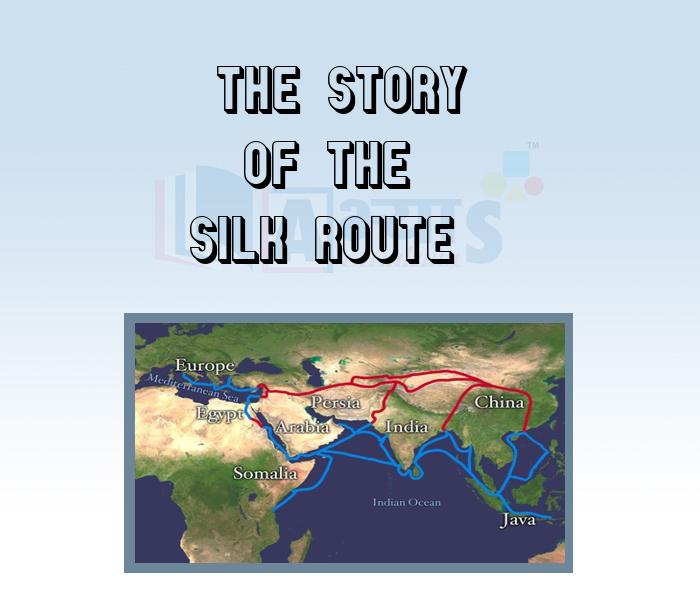The story of the silk route









The story of the silk route
The Story of The Silk Route: The rich, glossy colors of silk, as well as its smooth texture, make it a highly valued fabric in most societies. Making silk is a complicated process. Raw silk has to be extracted from the cocoons of silk worms, spun into thread and then woven into cloth. Techniques of making silk were first invented in china. While the methods remained a closely guarded secret for thousands of years, some people from china who went to distant lands on foot, horseback, and on camels, carried silk with them. The paths they followed came to be known as the silk route.
Chinese rulers sent gifts of silk to rulers in Iran and west Asia, and from there, the knowledge of silk spread further west. Wearing silk became the fashion amongst rulers and rich people in Rome. It was very expensive, as it had to be brought all the way from china, along dangerous roads, through mountains and deserts. People living along the route often demanded payments for allowing traders to pass through. Some kings tried to control large portions of the route. This was because they could benefit from taxes, tributes and gifts that were brought by traders travelling along the route. In return, they often protected the traders who passed through their kingdoms from attacks by robbers. The best- known of the rulers who controlled the silk route were the Kushanas, who ruled over central Asia and north-west India.
Their two major Centres of power were Peshawar and Mathura. Taxila was also included in their kingdom. During their rule, a branch of the silk route extended from central Asia down to the Sea ports at the mouth of the river Indus, from where silk was shipped westwards to the Roman Empire. The Kushanas were amongst the earliest rulers of the subcontinent to issue gold coins. These were used by traders along the silk route.
The Silk Route had two main branches-the northern route and the southern route. The southern route ran through northern Indian, across Khorasan in Central Asia and Mesopotamia to the Mediterranean Sea. The northern route ran north of the Tibetan Plateau through Russia to the Black Sea, and then to the Mediterranean Sea. The Chinese traded their raw and woven silk for spices, precious stones, pearls, ivory and raw cotton from India. Buddhism came to China along this route. Chinese inventions and discoveries like paper, gunpowder, porcelain and tea to the west.
Students / Parents Reviews [10]
About Abhyas metholodology the teachers are very nice and hardworking toward students.The Centre Head Mrs Anu Sethi is also a brilliant teacher.Abhyas has taught me how to overcome problems and has always taken my doubts and suppoeted me.

Shreya Shrivastava
8thI have spent a wonderful time in Abhyas academy. It has made my reasoning more apt, English more stronger and Maths an interesting subject for me. It has given me a habbit of self studying

Yatharthi Sharma
10thAbhyas Methodology is very good. It is based on according to student and each child manages accordingly to its properly. Methodology has improved the abilities of students to shine them in future.

Manish Kumar
10thMy experience with Abhyas academy is very good. I did not think that my every subject coming here will be so strong. The main thing is that the online tests had made me learn here more things.

Hiya Gupta
8thA marvelous experience with Abhyas. I am glad to share that my ward has achieved more than enough at the Ambala ABHYAS centre. Years have passed on and more and more he has gained. May the centre flourish and develop day by day by the grace of God.

Archit Segal
7thIt was good as the experience because as we had come here we had been improved in a such envirnment created here.Extra is taught which is beneficial for future.

Eshan Arora
8thAbhyas is a complete education Institute. Here extreme care is taken by teacher with the help of regular exam. Extra classes also conducted by the institute, if the student is weak.

Om Umang
10thIt was a good experience with Abhyas Academy. I even faced problems in starting but slowly and steadily overcomed. Especially reasoning classes helped me a lot.

Cheshta
10thMy experience with Abhyas is very good. I have learnt many things here like vedic maths and reasoning also. Teachers here first take our doubts and then there are assignments to verify our weak points.

Shivam Rana
7thMy experience was very good with Abhyas academy. I am studying here from 6th class and I am satisfied by its results in my life. I improved a lot here ahead of school syllabus.
